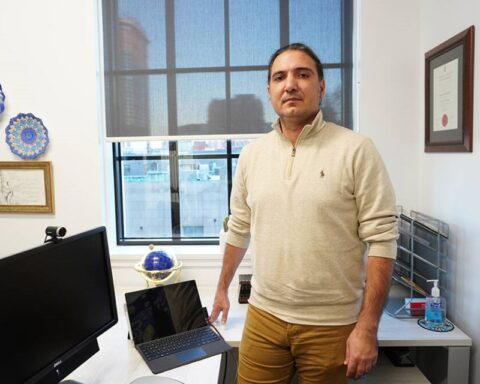I was in Italy on Oct. 3 when news broke about the overloaded ship that foundered off Santorino in the Mediterranean, resulting in the death of several hundred asylum seekers. Most the passengers were fleeing from Eritrea and Somalia.
A week later, a vessel carry another 250 asylum-seekers sank near the Italian island of Lampedusa, killing 39. They were Palestinians, Syrians and a few Egyptians. According to the UN’s refugee agency, more than 3,400 refugees have attempted to make the crossing from Egypt to Europe since August 2013, and the Mediterranean has been turned into a cemetery for many of those seeking a better future within the borders of the European Union.
Following global headlines, the chair of the St. Egidio Foundation at the Vatican urged European governments to open a safe corridor so that people who feel compelled to use this form of migration won’t find themselves at the mercy of inclement weather or rickety vessels. A plea by the director general of the Geneva-based International Organization for Migration (IOM), Lacy Swing, for Italy and fellow Mediterranean nations to work together to prevent this slaughter at sea appeared to fall on deaf ears.
“Renewed dialogue and cooperation should be underpinned by a shift in public discourse on migration, recognizing that migration is a process to be managed and not a problem to be solved,” the IOM director general pleaded.
European indifference
This continuing influx of people is a very thorny dilemma for the Europeans. I fault them mainly for not having a rational immigration policy that would allow managed migration in a way that would not jeopardize those who seek a better life through migration to the developed world.
The vast majority of the people who are arriving in Italy are not from Tunisia, Egypt or Libya. They are from Somalia, Ethiopia, Syria and sub-Saharan Africa. I would be the last one to defend most of the governments in that region based on their human rights records, but these spontaneous movements consist primarily of working age males or the families of working-age men who have successfully established themselves in Western Europe having previously used the same means themselves to obtain legal residence in Europe.
In my view, they have little to do with the so-called Arab Spring that has unleashed aspirations of democracy across the Middle East region.
The organizers of these refugee vessels tend to be what we would call criminal organizations who transport anyone who can pay their exorbitant fees. After drugs and the international arms trade, people smuggling is the most lucrative business operated by these people.
What the Europeans are doing in tolerating risky spontaneous movements and then using a refugee determination mechanism to sort survivors — who can stay and who can be sent back — is morally indefensible in my book. They really need to tackle the problem at the source. It would be better for all concerned if the EU and its constituent countries could decide on a policy for legal migration of both economic and humanitarian categories and then work in the source countries of the boat departures to curtail them as much as possible. The spontaneous movements more than anything benefit the smugglers.
The Canadian example
Canada has a rational migration policy which works assiduously in foreign ports and airports to interdict spontaneous migration. The argument that Canada is preventing would-be asylum seekers from arriving at our borders has to be measured against the reality that any channel open to spontaneous migration will be used by any number of people and probably not by that many who are in immediate need of international protection pursuant to the 1951 Geneva Convention and Protocol of 1967.
There is some evidence to suggest that intervention at source-nations has worked. The last refugee vessel to hit Canadian shores was in Aug. 2010, when the Sun Sea arrived off the B.C. coast, with 492 people on board. This vessel had originated in Thailand, but was carrying Sri Lankans of Tamil origin. Just 10 months earlier, another boatload of Tamils had arrived aboard a barely seaworthy Ocean Lady, setting off a debate across Canada about how the government should be treating these refugees fleeing a nation that was then in the throes of a fullblown civil war.
The Canadian debate resulted in the government drafting tough rules around who could be granted asylum and putting in place measures that would discourage such trafficking. Of the 575 people, including women and children, who filed refugee claims, only 130 have been successful. The rest are suspected to being supportive of the Tamil Tigers, a militant group that championed Tamil independence through extremist means.
In light of this, I maintain that Canada is as close as any country in trying to serve both the need to manage immigration and to reach out to some in need of resettlement on humanitarian grounds. Improvement is always possible, but I think Canada is on the right track.
Tunisia: The Story of Fatma, an anti-human trafficking campaign organized by IOM Tunisia.
IOM Youtube Feed
Raphael Girard retired from the federal government in 2003 after a 40-year career in Immigration and Foreign Affairs. He headed the Refugee Determination Task Force that created Canada’s refugee determination system in 1989. He served as Assistant Deputy Minister of Immigration Operations until 1997, following which he was named Canada’s Ambassador to Yugoslavia. He was Canadian delegate to the European Security Pact in 1999 and Ministerial Delegate for Reconstruction in the Balkans in the same year. He was appointed Canada’s Ambassador to Romania and Bulgaria in 2000.





